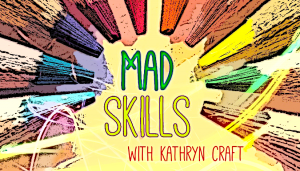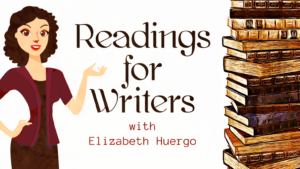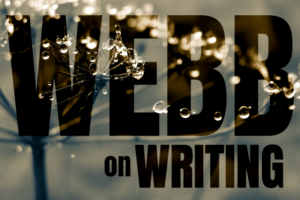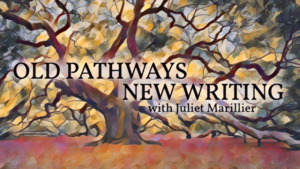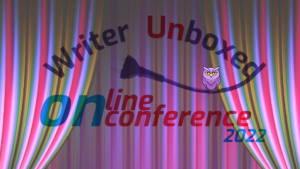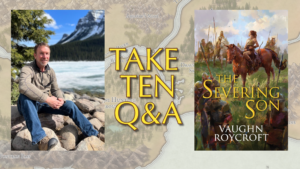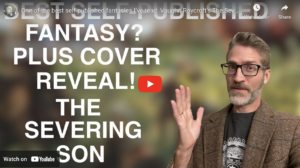Inspirations
From the moment a reader opens the cover of your book, she is looking for a protagonist to latch onto, a setting to sink into, and some clues as to the nature of the journey ahead. And whether or not this reader realizes it, knowing whose perspective will deliver the story will boost her ability to grasp its significance.
For writers hoping to explore many facets of a complex story, employing multiple third-person perspectives is a popular choice. By allowing the reader direct access to the inner thoughts of multiple characters, the author can clue the reader in on the train wreck to come while characters keep secrets, broker deals, and shift alliances.
Yet those same writers don’t always spend enough time figuring out how they will organize those multiple points of view so the reader can track them. Doing so is important. Assuming that omniscience allows you to dip into anyone’s perspective whenever you feel like it can result in “head hopping,” which refers to a fluid manner of accessing the thoughts and sensations of two or more point-of-view characters in one scene, one paragraph—or sometimes, even within the same sentence. This can leave the reader wrestling with unclear pronoun references at a time they hope to be learning what each character will add to the story.
Rather than provide the deep dive you were looking for, such brief POV dalliances can skip across the surface of your story, leaving conflicts underdeveloped—especially in an opening, when readers are trying to get to know the characters. For your sake and your readers’, it’s worth giving further consideration to how you’ll organize the perspectives through which you’ll tell your story.
Here are a few ways to do that.
1. Assign chapters
The easiest way to do organize multiple perspectives is to assign each POV character their own chapter. Each chapter could deliver a different point of view from the beginning, or you could just drop in an additional POV chapter when needed (for more on this technique, see my 2019 post about how Bryn Greenwood brilliantly pushed perspective to the max with sixteen POVs in her New York Times bestselling novel, All the Ugly and Wonderful Things). This will organize your approach even if its effect on your readers is subliminal.
At a writing retreat I attended while making final pass edits to The Far End of Happy, a bestselling author told me that the negative reviews for one of her novels were all from readers who were unclear as to which POV each chapter was being told from—despite her leaving copious clues. Since I was writing from the third-person points of view of three different women, this author advised me to stave off potential confusion by titling each chapter with the POV character’s name. I was lucky to trip across this advice—no author wants the hunt for a POV identity to pop the reader from the tension she’s worked hard to build.
2. Give your reader a break
A line break is another commonly accepted and easily recognizable way to signal a POV switch.
Let’s take a look at an excerpt from the 1978 novel Read More
If writing ever makes you feel lonely, consider Cecile Pineda’s work. You won’t find solace there. You will find a model of courage, of an artist living “at the edge of Being,” the phrase she uses in a 2004 interview with Jeff Biggers in The Bloomsbury Review. Pineda never offers readers the comfort of genre, of managed expectations. She never feigns a coherent, well-organized world or self. For her, the world is mutilated and nonsensical, and the self is shattered. She writes as she lives, balancing between life and death, always a soldier at the tip of the spear, never a general safe at the back of a fray. Didion could point to a center that wasn’t holding. Pineda would not, even to the point of madness.
What does madness feel like? In her memoir, Entry without Inspection: A Writer’s Life in El Norte, published in 2020, two short years before her death, she compares it to being “…evicted from yourself.” As she explains, your world vanishes. “There’s nothing left to fall back on, no sense of who you might be or where you might have come from or what dues you may have paid. Nowhere is your country, no one is your kin.” The burden of his undocumented status, that feeling that “[n]owhere is your country, no one is your kin,” lies at the heart of what she terms her “cultural deracination”:
My father made the decision to deprive me of a language (Spanish), in a sense to cut out my tongue. But he was not stupid. He understood this country, he respected the weight of its racism; the vacuum presented by its aspiritual culture. He made a conscious decision that I would speak French (my mother’s language) in place of Spanish. But I am fiercely proud—especially in the face of California State Proposition 187—of claiming my place as the child of an illegal.
Her mother is French. Her father is Mexican. Her father cuts away one of those two native tongues in order to protect her. She sutures her tongue, claims her place as a Chicana, only to find herself separated from the broader culture. Here is the “estrangement” that forges her identity as a writer living “at the edge of Being.” The title of her memoir refers to her father’s immigration status. He fled the Mexican Revolution in 1910 and crossed the border under an assumed name. Her memoir begins and ends with her father’s passage across the border and the resulting eclipse of his identity and hers.
Pineda drapes the story of her life over a ten-day arc, the story of Jean Blum, a Holocaust survivor and the whistleblower who drew national attention to the deaths of immigrants detained by ICE, immigrants like her father, who sought asylum but were criminalized instead, charged with “entry without inspection.” The connections between Blum’s story and Pineda’s are not random, though to readers demanding explanations, transitions, or sustained argument, Pineda throws down the gauntlet. Make what you will of these intersections between Blum’s story and mine, she seems to say; between the racism that ignited Hitler’s followers and the racism that ignites dehumanizing US government policies and border militias alike. She and Blum share “the story of a life in search of […]
Read Morephoto adapted / Horia Varlan
A story launches when something happens to a character that lands him in a troubling predicament. Life as he knew it can no longer continue on in the same way. He needs to do something, and his progress toward his goal will be defined by a desire he hopes to achieve.
But lurking beneath his hopeful journey is the threat of engaging with circumstances he hopes to avoid. Those circumstances are what we call stakes.
Like electrified wires that guard the edges of your protagonist’s path—and which, after he passes, seem to grow closer to each other and strengthen behind him—the stakes for failure drive the protagonist ever forward. Why are such stakes necessary? Because when we humans decide that a goal is demanding too much of us, we can easily convince ourselves that we never really wanted to achieve that goal in the first place. The negative repercussions in those stakes remind the protagonist: Want to turn back? Zzzzt! Wrong answer.
Since in real life most of us have been socialized not to electrocute our friends if they stray from their goals, you have to have mad respect for a writer who is willing to be so harsh with characters they have come to love. But their stories will benefit, because strong stakes for failure can create a gripping read.
In every scene of your book, the point-of-view character should face negative consequences if he or she is not able to overcome the obstacles standing between them and the successful attainment of his scene goal. It isn’t enough for the reader to know of the menace that’s always lurking beneath the plot. Sometimes, the menace must gain the upper hand.
This is how readers will know that your protagonist’s striving matters.
Today I want to look at three key moments when engaging with the stakes will help shape your novel.
While forming the story goal
The power of an inciting incident is found in its mandate: the character must take action (create a story goal) in order to set things right, or else. If he fails to act, he’ll have to engage with highly undesirable consequences. Delay is not an option. He must move forward into the story.
As much as Dorothy might want to hang around and dance with the creepy-yet-colorful Lollipop Guild when she lands in Oz, L. Frank Baum made sure this was not an option. Dorothy’s house had landed on a wicked witch, whose ruby slippers had magically transferred to her feet. The Lollipop kids deem her a hero for killing the witch, but the deceased’s evil sister wants the shoes back—and Dorothy can’t get them off her feet. When she hears that the Wizard of Oz might be able to help her, she must follow the Yellow Brick Road to find him.
Introducing the witch early provides impulsion to Dorothy’s journey, but it also tells us something about her. She didn’t mean to kill the witch and she doesn’t want to mess with this one either. Now, with stakes as high as her physical death (and her little dog’s, too!), she wants to get […]
Read MoreGreetings for the New Year, all! In 2023 I’m presenting a new series for WU, exploring how walking ancient pathways, physical or metaphorical, can strengthen writers in an age when humankind sometimes seems bent on destroying not only itself, but also the precious and beautiful natural world of which we are a part. I’ll build the series around the philosophies that guide me in life and in artistic practice. These owe a significant amount to my membership of a druid order, OBOD. But I am no spiritual leader. I’m an ordinary woman, I’m a writer, and I’m on a journey. The way is sometimes steep and stony, taking a toll on the bravest traveller. And it’s sometimes broad and sun-kissed, inviting the wayfarer to sprint, dance, or enjoy a quiet stroll with body and mind at ease. I hold out a hand and invite you to walk with me awhile.
We’ve been through a turbulent few years, and the dark clouds are still hanging over our world. Climate change, the pandemic, war, political instability, leaders held back from meaningful action by their own blinkered focus or by political systems that no longer seem adequate to deal with the challenges we face … I don’t know about you, but the weight of all that, and the feeling of powerlessness it brings, sometimes make it hard for me to keep on writing, let alone write the kind of fiction I usually love to create, stories in which characters can face some pretty grim challenges on their physical or psychological journeys, but which end, at the very least, with a note of learning, redemption and/or hope. Whether a story is set in the world as we know it, or in a different time, or in an invented world rich with magic, I present my characters with challenges we all know: the struggle to be brave, to be part of a community, to take meaningful action or to grow beyond prejudice. To own our true voice; to be worthy of love; to find the courage to walk away. When the world teeters on the brink of disaster, a storyteller must delve deep to uncover that note of hope.
I often wonder if the ability to tell stories is an inherited quality, something in the DNA. My ancestry has Celtic and pre-Celtic roots, and I think of myself as one link in a long line of storytellers. I imagine a time when my antecedents lived in a subsistence society, in which the patterns of the natural world – the changing seasons, the vagaries of the weather – played a major part in the survival of the tribe. A deep understanding of nature was vital to that society, and that included dealing with disasters such as fire, flood, famine and plague. In such a culture, oral storytelling around the fire at day’s end performed several functions. Entertainment, yes. Some of the silliest and funniest stories may have been invented to keep folk’s spirits up – to unite the group in laughter. But storytelling also teaches life lessons, presenting them in a way that engages and holds the interest of listeners. So, through the tales with their trappings of the bizarre and magical, their monsters […]
Read MoreTherese here to introduce you to today’s guest, Terah Shelton Harris. I met Terah on Twitter, where I learned that she is a librarian and freelance writer–with works appearing in Catapult, Women’s Health, Every Day with Rachel Ray, and more–and that she had tackled a very difficult topic for her debut novel, One Summer in Savannah. I’m so pleased that she accepted the invitation to write for WU to share her experience–why she traveled the road she did, how it stretched her as a writer, and how her topic asked her to consider her readers.
“Terah Shelton Harris’s daring debut is nothing short of astonishing. To write a novel that has the capacity to uplift you while it tears your heart to shreds is a balancing act few can achieve, but Harris does with ease and endless empathy. We are brought face-to-face with the most difficult questions––of family, forgiveness, and how to make a way forward––but if we can muster the courage of characters like Sara and Jacob, we will find answers that sustain us for years to come. The best writers are brave writers, and Harris has proven herself among those ranks.” —Mateo Askaripour, New York Times bestselling author of Black Buck
You can learn more about Terah and her debut novel, which releases on July 11th, on her website. You can also follow her on Twitter and Instagram. Welcome, Terah!
As writers, we invite readers on a journey. We take their hands and escort them to a crime scene to solve a mystery. We take them on a character’s path to self-discovery or inside the ups and downs of a relationship. We invite them to imagine worlds that do not exist. But sometimes the journey isn’t to far-flung destinations. Sometimes that journey isn’t very far at all. Sometimes the journey lies within the reader.
As writers, we need to consider what we ask of readers as we write. For example:
How do YOU define forgiveness? What is it? And what does it mean to you? My debut novel challenges readers to explore the definition of forgiveness and what it truly means to forgive.
Because my own understanding of forgiveness was challenged.
Inspiration for my novel stems from the 2015 Emanuel African Methodist Episcopal Church shooting. After the parishioners fed him and prayed for him, Dylann Roof shot and killed nine of them. Days after that terrible tragedy, before they had even buried their loved ones, some of the survivors and relatives of those killed walked into a South Carolina courtroom and forgave Roof. Everything I thought I knew and understood about forgiveness shattered. At that moment, I realized I knew nothing about forgiveness. I assumed that there were crimes and acts that were unforgivable. I learned the opposite. The loved ones who forgave Roof taught me that forgiveness is not one-size fits all and unknowingly challenged me to look inward to create and test my own definition of forgiveness.
Writing isn’t supposed to be comfortable or easy, and neither is reading. Rather than running from what makes us uncomfortable, we can take risks, challenge ourselves, and take our readers along with us.
While my novel doesn’t involve a situation like […]
Read MorePlease welcome guest author Henriette Lazaridis to Writer Unboxed today! Henriette’s new novel, TERRA NOVA, will be published by Pegasus Books in December 2022. Her debut novel, The Clover House, was a Boston Globe bestseller and a Target Emerging Authors pick. Her work has been published in such outlets as Elle, Forge, Narrative Magazine, The New York Times, New England Review, The Millions, WBUR’s Cognoscenti and Pangyrus, and she is a recipient of a Massachusetts Cultural Council Artists Grant. Henriette earned degrees in English literature from Middlebury College, Oxford University, where she was a Rhodes Scholar, and the University of Pennsylvania. Having taught English at Harvard, she now teaches at GrubStreet in Boston. Visit her website at https://www.henriettelazaridis.com/.
Linger, Tinker, Savor: Taking the Time to Get it Right
I came to novel-writing later in life, after a career in academia. Though I’d decided as a teenager that I wanted more than anything to be a novelist, one thing led to another, and I detoured into scholarship and teaching at the university level, and then I was almost forty when I realized I’d strayed from my once-held dream. Starting “late”—or so I thought—I became a Woman in a Hurry. It’s not that I wrote massive amounts right away. Quite the contrary, in fact. I didn’t take myself seriously for a few years and kept undermining myself by engaging in all manner of other pursuits on top of (and often in place of) writing. But even then, I was in a hurry mentally. When I did finally get serious about writing novels, I wanted everything to happen fast.
My first novel, The Clover House, set me up for some false expectations of speed to come. The novel went on sub on a Thursday and, by the Monday, I had phone interviews with three publishers. About three weeks later, I had a sale. This gave me the impression it would always go like this. You write the draft, you revise a little, you go on sub, and bingo, you sell. I imagined doing this on a sort of two-year timetable and queued up my ideas accordingly.
Insert a pause for sad-maniacal laughter.
No, the next manuscript I wrote did not go off into publication at lightning speed. Nor did the next one. But though the publishing world’s operations were slowing me down, I continued to write if not quickly then briskly. I began a third manuscript, and then set it aside to revise one of the two novels I’d already completed, reworking it under the skillful and attentive scrutiny of my then agent. Before the ink was barely dry on a finished draft of Terra Nova, I began and finished another manuscript, during the pandemic (didn’t everyone?), in a matter of months.
The take-away from all these manuscripts bouncing around in my writerly existence isn’t the speed of their creation. That’s, in fact, the cautionary tale. The real lesson is that the ones that really succeeded were the product of time and slowness. Notice that while we have a nifty word for when things are fast—speed!—the word for when things are slow is awkward. Slowness? And yet, there it is: a word that takes as much drawn-out time to say as is fitting for its meaning. What worked best for me as a […]
Read MorePlease welcome longtime Writer Unboxed community member Lancelot Schaubert back as our guest today! Lance is the author of the novel Bell Hammers.
“Schaubert recounts a mischievous man’s eight decades in Illinois’s Little Egypt region in his picaresque debut BELL HAMMERS. Remmy’s life of constant schemes and pranks and a lifelong feud with classmate Jim Johnstone and the local oil drilling company proves consequential. This is a hoot.”
– Publisher’s Weekly
More about Lance from his bio:
Two excerpts of Lancelot Schaubert’s (lanceschaubert.org) debut novel BELL HAMMERS sold to The New Haven Review (Yale’s Institute Library ) and The Misty Review, while a third excerpt was selected as a finalist for the last Glimmer Train Fiction Open in history. He has also sold poetry, fiction, and nonfiction to TOR (MacMillan), The Anglican Theological Review, McSweeney’s, Poker Pro’s World Series Edition, The Poet’s Market, Writer’s Digest, and many similar markets.
Spark + Echo chose him for their 2019 artist in residency, commissioning him to write four short stories.
He has published work in anthologies like Author in Progress, Harry Potter for Nerds, and Of Gods and Globes — the last of which he edited and featured stories by Juliet Marillier (whose story was nominated for an Aurealis award), Anne Greenwood Brown, Dr. Anthony Cirilla, LJ Cohen, FC Shultz, and Emily Munro. His work Cold Brewed reinvented the photonovel for the digital age and caught the attention of the Missouri Tourism Board who commissioned him to write and direct a second photonovel, The Joplin Undercurrent, in partnership with award-winning photographer, Mark Neuenschwander.
Lance shares free resources for writers on his website, HERE, where you can also learn more about him.
Stanza I: The Dragon.
In every medieval occidental story about dragons — actually, even in some of the medieval luck dragon stories — a dragon unattended grows. When it’s an occidental dragon, your own and the dragon’s greed and anxiety and unattended consequences worsen. The longer you refuse to face it, to do something — anything — to try to deal with the problem, the more the problem grows. That’s the nature of invasive species, of viruses (can I get a witness?), of mold, and of extended family drama or workplace gossip. It’s the nature of ignoring preventative maintenance for your mental health, of waiting until you’re 55 to start working out (you lose 1% of your muscle mass from that point on until you die), and of waiting for an oil change in your car (a relative of mine blew hers up this way).
It’s also the case internally. The problem left unattended grows your anxiety, your bitterness, your shame. Your refusal to grieve, to encounter the world with wonder, to play, to dance in the minefields — these all grow the problem in your mind. And so (to borrow a metaphor from a shared text, setting aside the reasons we share it) while Voldemort grows in the world, he also grows in your head. And you have to deal with the Voldemort within in order to kill the Voldemort without.
The longer you ignore the dragon, the bigger he gets.
How do you think Smaug got so powerful?
No homely lakelander wanted to deal with a dragon. No dwarf would harm his hoard.
Stanza II: The mice […]
Read Morephoto adapted / Horia Varlan
First, let me be clear: the songwriter referred to in the above headline is not me. I have written all of one song in my life, in apology to my mother for being someone different than the person she’d hoped I’d be. (Singing it for her diffused the tension in our relationship, so I quit while I was ahead and stopped short of trying to sell it in Nashville.)
No, the singer-songwriter whose mad skills inspired today’s post is Dar Williams, whose folk career rose to popular acclaim in the 1990s while opening for Joan Baez on an international tour. With that jump-start, she sustained her career in the same manner as do many authors: by appearing where she could in small-town venues across the country.
I was literally sitting two feet away from Dar Williams. #notfangirling
Amazingly, Dar made a September appearance in the hamlet closest to my summer home in northern New York State, where trees outnumber people a gazillion to one. Her tour was in conjunction with the release of her book, How to Write a Song that Matters, based on the songwriting retreats she’s been hosting since 2013. This meant that before her evening concert in the opera house at one end of town, I was also able to hear her speak about her creative process at the library three blocks away (yes, at the other end of town!) and pick up a copy of her book.
This was not because I hoped to further my songwriting career, but because as anyone who has read my chapter in Author in Progress (Therese Walsh, ed.) knows, I often find writing mentors and muses hidden within other art forms. Because songwriting is a shorter form, we wordy novelists can learn a thing or two from the way Dar focuses her message.
1. Zero in on your audience
Yes, I think of her as “Dar.” Cheeky, right? I talked to her for all of two minutes in a signing line. But I’m pretty sure everyone who’s heard her speak about songwriting or has heard her perform thinks of her as a friend.
As Dar’s foray into the North Country woods suggests, her listeners matter. Dar pays keen attention to the places where she’ll perform and the people she meets there, and then makes good use of the details she accumulates. They fuel the conversation she has with her audience, inspire new songs, allow her to publicly thank the town’s arts champions as well as some of its inhabitants by name, and even resulted in her first book, What I Found in a Thousand Towns. Add lyrics that feel personal and true, and the audience feels like she’s “one of us.”
Pro tip to build your audience: An audience is built one person at a time. Whether at a conference, a book signing, or speaking in a lecture hall, learn something about the town. Interact with bookstore personnel, organizers, and other authors as well as readers. Use names whenever you can. An interaction that feels personal […]
Read MoreIt’s a great pleasure to share our in-depth interview with regular WU contributor, assistant editor, stellar community member, and now published author Vaughn Roycroft, on the publication day of his debut novel, THE SEVERING SON! For as long as we’ve known Vaughn, he’s worked to craft this story world–a journey that has lasted nearly two decades and provided material for six novels. The first of those novels, out today as an e-book and in paperback, has already created waves in the fantasy world.
“With a fast pace and sweeping battle sequences, not to mention one of the best duels in fiction, The Severing Son will appeal to action-hungry readers of such authors as John Gwynne, George R.R. Martin, and Evan Winter.”
— Philip Chase, PhD aka YouTube’s Dr. Fantasy
“The author blends history with imagination to create a dramatic and engaging story. The Severing Son will appeal to lovers of historical fiction and epic fantasy enthusiasts alike.”
— Juliet Marillier, author of the Blackthorn & Grim and Warrior Bards series
Read on for an inspiring look back at what it took for Vaughn to get to this moment, and what’s next for him and his career.
Congratulations, Vaughn!
Which character did you imagine first, and what was it about him/her that made you sit down and write?
VR: I perfectly recall the day that I jotted down my first story idea in the world that became Dania and Pontea. I was working as a carpenter, rehabbing an older cottage. I was waiting for a concrete delivery, to pour a slab for a new porch, and I jotted it down in a pocket-sized notepad with a carpenter’s pencil. I’d already been reading about the fall of Rome and the role of the Goths in it.
I can’t find the notepad anymore, but the idea revolved around a Gothic scion, about to come of age, who wanders to the mountains at the border of his people’s realm, on the fringes of the empire. I immediately imagined ancient ramparts and the ruins of a tower and gate. I knew the young man was about to encounter someone who’d known his father. I knew he didn’t recall his father, who had left their homeland years prior, only to become entangled with the empire.
But the most important and memorable part of getting this vision—the thing that had me super excited—was that the scion was secretly being watched by a guardian. I immediately knew the guardian was a warrior woman who was about his age, and that she’d been assigned to him. I imagined her as being super competent and a bit dismayed by the bumbling nature of her subject (this is how my super competent wife plays into the original idea).
So the answer to the question is that I first imagined Thaedan and Ainsela, the son and niece respectively of Vahldan and Elan, the protagonists of my forthcoming debut, The Severing Son.
Thaedan’s and Ainsela’s unique relationship, its awkwardness and promise, was the thing that finally—after several years of “intending to write”—got my butt into the chair and words on the page.
I’m glad we’re able to talk about this early—the scope of this story, the multi-generational nature of the world you’ve created […]
Read Morephoto adapted / Horia Varlan
A disheartened writing friend recently said to me, “I don’t even know why I’m writing this book. We’ve just been through three years of Covid. Who wants to read about grief?”
Well, if she was wondering who wants to read an entire novel about the kind of despondency that results when people become enmired in the emotion of grief, she’s right, her readership might be scant. But if she’s asking who needs to read about the act of grieving—entering into it without warning, navigating its challenges, and emerging from its grasp with new perspective? Well, that’s pretty much what fiction is all about.
“Want the change. Be inspired by the flame
where everything shines as it disappears.”
~Rainer Maria Rilke
All stories begin when a character must relinquish his attachment to the way things were: whether to a loss due to physical death, divorce, or a job; the old way of doing things; the need to leave a home; the forfeiture of rights or freedoms; a huge shift in identity. Covid exacted loss in all of these forms and more, knocking many of your potential readers right onto their backsides. The effects are playing out still, and will be for a long time. Even if your story is not set in a Covid world, it can help readers take stock of their losses and figure out how to move forward.
On his two-hour(!) podcast episode “The Science and Process of Healing from Grief,” neuroscientist Andrew Huberman, PhD, shared research that explains why moving forward can be so hard after a loss: in essence, our ability to predict our next interaction with our beloved (person, animal, object, place, vocation) in space and time is closely tied to our sense of our attachment to them. Grieving requires that we untangle that complex space/time/attachment relationship. After a loss, we continue to feel the attachment, yet our brains can’t figure out when or where we’ll once again see our beloved.
In this episode, Huberman read a letter from Nobel Prize-winning physicist Richard Feynman to his childhood sweetheart and wife, Arline, who died at age 25 from tuberculosis. Feynman begins by apologizing for not writing in so long—he’d regularly written her love letters before, but it took him almost two years to write this letter to her after her death. At one point he writes, “You can give me nothing now, yet I love you so much that you stand in the way of my loving anything else. But I wanted you to stand there. You, dead, are so much better than anyone else alive.” His letter ends with this tragicomic post-script: “Please excuse my not mailing this but I don’t know your new address.”
Feynman “knew” that his wife was dead—in the letter he even referred to her in the third person at one point, saying, “My wife is dead”—and yet his attachment remains. This is because our brains can’t easily conceptualize when something isn’t there anymore, Huberman explains. Neurons are dedicated to our attachments based on our experience […]
Read MoreWe usually wait to share book reviews for our interview days here at Writer Unboxed, but this morning our dear friend and one of my two extremely appreciated assistant editors, Vaughn Roycroft, received his first review. And I just can’t help but share it, and not just because I know how much heart and perseverance went into this series for Vaughn, but because I just can’t help but think YOU would also want me to share it as well.
Bonus: The FINAL cover is revealed at the end.
Email readers, you can access the YouTube video, titled, One of the best self-published fantasies I’ve read: Vaughn Roycroft’s The Severing Son, directly HERE.
Enjoy!
Read More
